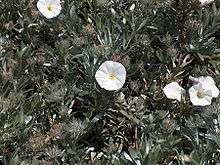Convolvulus cneorum
| Silverbush | |
|---|---|
 | |
| Scientific classification | |
| Kingdom: | Plantae |
| Clade: | Angiosperms |
| Clade: | Eudicots |
| Clade: | Asterids |
| Order: | Solanales |
| Family: | Convolvulaceae |
| Genus: | Convolvulus |
| Species: | C. cneorum |
| Binomial name | |
| Convolvulus cneorum | |
Convolvulus cneorum, also known as silverbush or shrubby bindweed,[1] is a species of flowering plant in the family Convolvulaceae, which contains many plants described as "bindweed". However, unlike other species in the genus, it is an evergreen shrub rather than a vine, forming a low mound 0.6–1.2 m (2 ft 0 in–3 ft 11 in) in height, with a similar spread. It produces 2.5–4 cm (1–2 in) diameter flowers which are white with a yellow throat. These are produced at the end of stems in loose panicles and may almost completely cover the plants. The leaves are grey-green and are covered in fine hairs which give the plant a silvery appearance.[2]
Distribution
The species is found in coastal areas of Spain, Italy, Croatia and Albania[2] In Italy it is found on the coast of Tuscany and western Sicily and on the islands of Capri and Li Galli. In Croatia it is found on many of the islands off the coast. It is often found growing in cracks in rocks.[3]
The Latin specific epithet cneorum is a word of Greek origin referring to a small olive-like plant, possibly a species of Daphne.[4]
Cultivation
The species prefers an alkaline soil, full sun and good drainage. It is cold hardy to −9 C.[2] It has gained the Royal Horticultural Society's Award of Garden Merit[1] (confirmed 2017).[5]
References
- 1 2 "RHS Plantfinder – Convolvulus cneorum". Retrieved 30 January 2018.
- 1 2 3 Irish, M. (2006-02-06). Perennials for the Southwest: Plants That Flourish in Arid Gardens. United States: Timber Press. p. 314. ISBN 978-0-88192-761-0. ISBN 0-88192-761-9.
- ↑ Pandza, M. (March 2002). "Localities of the species Convolvulus cneorum L. (Convolvulacae in Croatia". Nat. Croat. 11 (1): 113–118. ISSN 1330-0520. Retrieved 2007-12-08.
- ↑ Harrison, Lorraine (2012). RHS Latin for Gardeners. United Kingdom: Mitchell Beazley. ISBN 184533731X.
- ↑ "AGM Plants – Ornamental" (PDF). Royal Horticultural Society. July 2017. p. 22. Retrieved 24 January 2018.